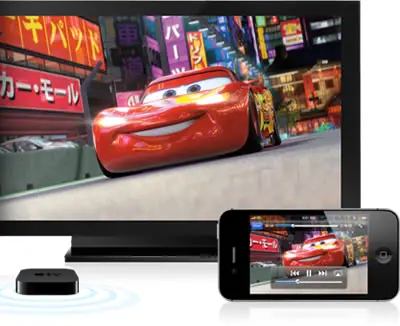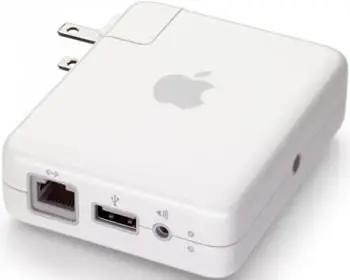Configuring AirPlay on Your iPhone
Considering that at least some external equipment is necessary to receive any wireless streams emitting from the iPhone, Apple has hidden AirPlay's settings from view until your device detects one of those outside products. If you have an AirPort Express, an AirPlay-certified A/V receiver or speaker, or an Apple TV, you'll see a new icon in a semi-concealed place that you wouldn't otherwise see. First off, you need to ensure that your iPhone and your AirPlay accessory are connected on the same Wi-Fi network. If they are, the "discovery" process happens automatically on the iPhone, although you may have to reboot it if it doesn't recognize the device(s) right away. To find out, simply double-tap the Home button to bring up the Secondary Dock bar at the bottom. Swipe from left to right twice to bring up the control bar, and look for a rectangular icon with an arrow on the bottom. That's AirPlay, and it's shown in Figure below.

Tip:
Here's one little-known fact about AirPlay: Any previously paired Bluetooth speakers (such as the fantastic Jambox from Jawbone) will also show up in the list of AirPlay-enabled devices, allowing you to start streaming music even to Bluetooth devices from the same menu, using the same controls.
Press that icon, and your discovered devices should be shown. You select the one to which you want to stream give it a moment to pair, and you're configured. If only washing dishes, mowing the lawn, and filing taxes were this easy.
Tip:
While you are in the setup mood, it is worth your while to download Apple's Remote app from the App Store. It's a free program that allows your iPhone to control your Mac's iTunes library wirelessly. It also gives you total control of AirPlay-connected devices (with a highly intuitive user interface), and you can search for things by typing on a pop-up QWERTY keyboard right on the display. It quite literally turns your iPhone into an oversized touch-panel remote.
Reason to Consider AirPort Express
As if you didn't have reason enough to spring for Apple's prior-generation AirPort Express (remember how useful it is in spreading a single hotel Ethernet connection to all of your Wi-Fi travel companions?), it also acts as the cheapest, most seamless way to send a signal to an audio system you already own from the iPhone. And yes, that includes wired audio systems. The AirPort Express has a 3.5mm minijack that supports analog and optical audio cables (shown in Figure below). Connect this jack to an existing A/V receiver or speaker input, and that's the last cable you'll need to run. From there, your iPhone can send audio from the Music app directly to the AirPort Express with no wire in between, allowing whatever speaker system is attached to have the tracks and volume dictated remotely and wirelessly right on the phone.

AirPort Express is easily one of Apple's most awkwardly named and universally understated products. But then again, not really sure there even exists a succinct way to name a product that does so much. Sure, it's a mobile broadband router that can be plugged into any home outlet. But the audio jack on the bottom is extremely powerful in conjunction with AirPlay. You can connect your AirPort Express to your home stereo or powered speakers using a digital fiber optic cable, analog mini-stereoto- dual-RCA cable, or mini-stereo to mini-stereo cable (depending on what type of connectors your stereo uses) connected to the Line Out port. Better still, you can stream iTunes music to more than one AirPort Express at a time by choosing Multiple Speakers from the Speakers pop-up menu (assuming, of course, you actually have multiple AE base stations installed). In other words, you can place an AirPort Express in every room where you have a receiver or speaker set up, and then broadcast music to each of those rooms from a single iPhone. House parties just became entirely more feasible.
It's important to note that Apple changed the AirPort Express design in 2012. The prior model, which is still available from the online Apple Refurbished Store for $69 (or eBay, failing that). The new one requires a lengthy power cord, which makes it less useful for travel.
Configuring Your AirPort Express
Setting up AirPort Express is as simple as tapping into the AirPort utility on your Mac, or the like-named app on your iPhone (it's available as a free download from the App Store). But there are litanies of possible configurations, which are worth going over in detail here.
- You can use an AirPort Express exclusively as a wireless streaming liaison, without ever tapping into its other powers in the networking space. Simply connect your speakers to the 3.5mm jack, plug the device into a nearby AC outlet, and select it as an AirPlay-compatible streaming device within iTunes or on the iPhone's AirPlay menu.
- If an AirPort Express is your primary wireless router, you'll need to ensure your speaker system and Internet modem are near enough to both reach the device. Then, in AirPort Utility, ensure that Enable AirPlay/AirTunes is checked in the Music tab when creating a new wireless network.
- If your AirPort Express is acting as a music streaming device and an extension of a network that's connected via Ethernet, you'll need to again ensure that your speaker(s) and router are both within reach. Once the Ethernet and 3.5mm cable are connected, you'll need to use the AirPort Utility to configure AirPort Express as part of a roaming network, and ensure that Enable AirPlay/AirTunes is checked in the AirPort Utility Music tab.
- If you're connecting your AirPort Express to your wireless network in client mode-in other words, only for its wireless printing and audio streaming capabilities-you'll need to join the AirPort Express SSI D from your list of available wireless networks. On a Mac, you can use the AirPort status menu in the menu bar; on a Windows-based computer, hold the pointer over the wireless connection icon until you see your AirPort network name.
- If you're setting up your AirPort Express as a wireless repeater or extender to your existing wireless network, you'll simply need to ensure that Enable AirPlay/AirTunes is checked in the AirPort Utility Music tab, and connect to it as you would in the first example.
Warning:
If you're planning to use the AirPort Express as a wireless repeater or extender to your existing wireless network, it's worth investigating the protocols supported on your other wireless router. If it's in 802.11b/g mode, switch your AirPort Express to the same. If one is using 802.11b/g/n, allow your AirPort Express to follow suit. Don't mix and match network protocols across devices. Lots of connection problems and interference when various routers on the same network are using different wireless technologies to broadcast.
